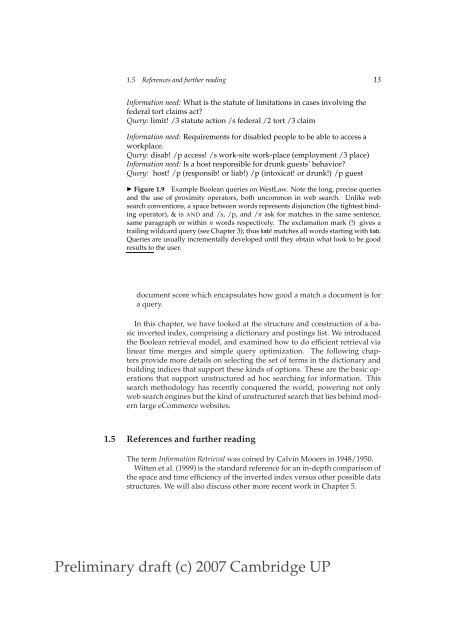Preliminary draft (c) 2007 Cambridge UP - Villanova University
Preliminary draft (c) 2007 Cambridge UP - Villanova University
Preliminary draft (c) 2007 Cambridge UP - Villanova University
You also want an ePaper? Increase the reach of your titles
YUMPU automatically turns print PDFs into web optimized ePapers that Google loves.
1.5 References and further reading 13<br />
Information need: What is the statute of limitations in cases involving the<br />
federal tort claims act?<br />
Query: limit! /3 statute action /s federal /2 tort /3 claim<br />
Information need: Requirements for disabled people to be able to access a<br />
workplace.<br />
Query: disab! /p access! /s work-site work-place (employment /3 place)<br />
Information need: Is a host responsible for drunk guests’ behavior?<br />
Query: host! /p (responsib! or liab!) /p (intoxicat! or drunk!) /p guest<br />
◮ Figure 1.9 Example Boolean queries on WestLaw. Note the long, precise queries<br />
and the use of proximity operators, both uncommon in web search. Unlike web<br />
search conventions, a space between words represents disjunction (the tightest binding<br />
operator), & is AND and /s, /p, and /n ask for matches in the same sentence,<br />
same paragraph or within n words respectively. The exclamation mark (!) gives a<br />
trailing wildcard query (see Chapter 3); thus liab! matches all words starting with liab.<br />
Queries are usually incrementally developed until they obtain what look to be good<br />
results to the user.<br />
document score which encapsulates how good a match a document is for<br />
a query.<br />
In this chapter, we have looked at the structure and construction of a basic<br />
inverted index, comprising a dictionary and postings list. We introduced<br />
the Boolean retrieval model, and examined how to do efficient retrieval via<br />
linear time merges and simple query optimization. The following chapters<br />
provide more details on selecting the set of terms in the dictionary and<br />
building indices that support these kinds of options. These are the basic operations<br />
that support unstructured ad hoc searching for information. This<br />
search methodology has recently conquered the world, powering not only<br />
web search engines but the kind of unstructured search that lies behind modern<br />
large eCommerce websites.<br />
1.5 References and further reading<br />
The term Information Retrieval was coined by Calvin Mooers in 1948/1950.<br />
Witten et al. (1999) is the standard reference for an in-depth comparison of<br />
the space and time efficiency of the inverted index versus other possible data<br />
structures. We will also discuss other more recent work in Chapter 5.<br />
<strong>Preliminary</strong> <strong>draft</strong> (c)<strong>2007</strong> <strong>Cambridge</strong> <strong>UP</strong>



